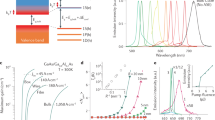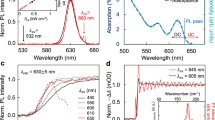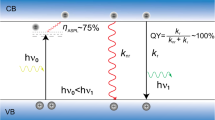Abstract
Strongly confined colloidal quantum dots have been investigated for low-cost light emission and lasing for nearly two decades. However, known materials struggle to combine technologically relevant metrics of low-threshold and long inverted-state lifetime with a material gain coefficient fit to match cavity losses, particularly under electrical excitation. Here we show that bulk nanocrystals of CdS combine an exceptionally large material gain of 50,000 cm−1 with best-in-class gain thresholds below a single exciton per nanocrystal and 3 ns gain lifetimes not limited by non-radiative Auger processes. We quantitatively account for these findings by invoking a strong bandgap renormalization effect, unobserved in nanocrystals to date, to the best of our knowledge. Next, we demonstrate broadband amplified spontaneous emission and lasing under quasi-continuous-wave conditions. Our results highlight the prospects of bulk nanocrystals for lasing from solution-processable materials.
This is a preview of subscription content, access via your institution
Access options
Access Nature and 54 other Nature Portfolio journals
Get Nature+, our best-value online-access subscription
$29.99 / 30 days
cancel any time
Subscribe to this journal
Receive 12 print issues and online access
$259.00 per year
only $21.58 per issue
Buy this article
- Purchase on Springer Link
- Instant access to full article PDF
Prices may be subject to local taxes which are calculated during checkout





Similar content being viewed by others
Data availability
The datasets are available from the corresponding author upon reasonable request.
References
Zhang, Q., Tao, W., Huang, J., Xia, R. & Cabanillas-Gonzalez, J. Toward electrically pumped organic lasers: a review and outlook on material developments and resonator architectures. Adv. Photon. Res. 2, 2000155 (2021).
Park, Y.-S., Roh, J., Diroll, B. T., Schaller, R. D. & Klimov, V. I. Colloidal quantum dot lasers. Nat. Rev. Mater. 6, 382–401 (2021).
Geiregat, P., Van Thourhout, D. & Hens, Z. A bright future for colloidal quantum dot lasers. npg Asia Mater. 11, 41 (2019).
Pietryga, M. et al. Spectroscopic and device aspects of nanocrystal quantum dots. Chem. Rev. 116, 10513–10622 (2016).
Shirasaki, Y., Supran, G. J., Bawendi, M. G. & Bulović, V. Emergence of colloidal quantum-dot light-emitting technologies. Nat. Photon. 7, 13–23 (2012).
Semonin, O. E. et al. Peak external photocurrent quantum efficiency exceeding 100% via MEG in a quantum dot solar cell. Science 334, 1530–1533 (2011).
Deng, Z., Jeong, K. S. & Guyot-Sionnest, P. Colloidal quantum dots intraband photodetectors. ACS Nano 8, 11707–11714 (2014).
Livache, C., Martinez, B., Goubet, N., Ramade, J. & Lhuillier, E. Road map for nanocrystal based infrared photodetectors. Front. Chem. 6, 575 (2018).
Garcia de Arquer, F. P., Armin, A., Meredith, P. & Sargent, E. Solution-processed semiconductors for next-generation photo-detectors. Nat. Rev. Mater. 2, 16100 (2017).
Klimov, V. I. et al. Optical gain and stimulated emission in nanocrystal quantum dots. Science 290, 314–317 (2000).
Klimov, V. I. et al. Single-exciton optical gain in semiconductor nanocrystals. Nature 447, 441–446 (2007).
Wu, K., Park, Y.-S., Lim, J. & Klimov, V. I. Towards zero-threshold optical gain using charged semiconductor quantum dots. Nat. Nanotechnol. 12, 1140–1147 (2017).
Geiregat, P. et al. Continuous-wave infrared optical gain and amplified spontaneous emission at ultralow threshold by colloidal HgTe quantum dots. Nat. Mater. 17, 35–42 (2017).
Cassidy, J. et al. Quantum shells boost the optical gain of lasing media. ACS Nano 16, 3017–3026 (2022).
Ithurria, S. et al. Colloidal nanoplatelets with two-dimensional electronic structure. Nat. Mater. 10, 936–941 (2011).
Guzelturk, B., Pelton, M., Olutas, M. & Demir, H. V. Giant modal gain coefficients in colloidal II-VI nanoplatelets. Nano Lett. 19, 277–282 (2018).
Geiregat, P. et al. Thermodynamic equilibrium between excitons and excitonic molecules dictates optical gain in colloidal CdSe quantum wells. J. Phys. Chem. Lett. 10, 3637–3644 (2019).
Li, Q., Liu, Q., Schaller, R. D. & Lian, T. Reducing the optical gain threshold in two-dimensional CdSe nanoplatelets by the giant oscillator strength transition effect. J. Phys. Chem. Lett. 10, 1624–1632 (2019).
Bisschop, S., Geiregat, P., Aubert, T. & Hens, Z. The impact of core/shell sizes on the optical gain characteristics of CdSe/CdS quantum dots. ACS Nano 12, 9011–9021 (2018).
Fan, F. et al. Continuous-wave lasing in colloical quantum dot solids enabled by facet-selective epitaxy. Nature 544, 75–79 (2017).
Lim, J., Park, Y.-S. & Klimov, V. I. Optical gain in colloidal quantum dots achieved with direct-current electrical pumping. Nat. Mater. 17, 42–49 (2017).
Yang, Z., Pelton, M., Fedin, I. & Talapin, D. V. A room temperature continuous-wave nanolaser using colloidal quantum wells. Nat. Commun. 8, 143 (2017).
Xie, W. et al. On-chip integrated quantum-dot silicon-nitride microdisk lasers. Adv. Mater. 29, 1604866 (2017).
Xie, W. et al. Colloidal quantum dots enabling coherent light sources for integrated silicon-nitride photonics. IEEE J. Sel. Topics Quantum Electron. 23, 8200913 (2017).
Jung, H. et al. Two-band optical gain and ultrabright electroluminescence from colloidal quantum dots at 1,000 A cm–2. Nat. Commun. 13, 3734 (2022).
Ahn, N. et al. Electrically driven amplified spontaneous emission from colloidal quantum dots. Nature 617, 79–85 (2023).
Chernikov, A., Ruppert, C., Hill, H. M., Rigosi, A. F. & Heinz, T. F. Population inversion and giant bandgap renormalization in atomically thin WS2 layers. Nat. Photon. 9, 466–470 (2015).
Hens, Z. & Moreels, I. Light absorption by colloidal semiconductor quantum dots. J. Mater. Chem. 22, 10406 (2012).
Ghobadi, N. Band gap determination using absorption spectrum fitting procedure. Int. Nano Lett. 3, 2 (2013).
Maes, J. et al. Size and concentration determination of colloidal nanocrystals by small-angle X-ray scattering. Chem. Mater. 30, 3952–3962 (2018).
Thambidurai, M. et al. Strong quantum confinement effect in nanocrystalline CdS. J. Mater. Sci. 45, 3254–3258 (2010).
Aubert, T. et al. General expression for the size-dependent optical properties of quantum dots. Nano Lett. 22, 1778–1785 (2022).
Geiregat, P. et al. Using bulk-like nanocrystals to probe intrinsic optical gain characteristics of inorganic lead halide perovskites. ACS Nano 12, 10178–10188 (2018).
Rodà, C. et al. Stimulated emission through an electron-hole plasma in colloidal CdSe quantum rings. Nano Lett. 21, 10062–10069 (2021).
Di Stasio, F., Polovitsyn, A., Angeloni, I., Moreels, I. & Krahne, R. Broadband amplified spontaneous emission and random lasing from wurtzite CdSe/CdS ‘giant-shell’ nanocrystals. ACS Photon. 3, 2083–2088 (2016).
Aellen, M. & Norris, D. J. Understanding optical gain: which confinement factor is correct? ACS Photon. 9, 3498–3505 (2022).
Hirose, K. et al. Watt-class high-power, high-beam-quality photonic-crystal lasers. Nat. Photon. 8, 406–411 (2014).
Sakata, R. et al. Photonic-crystal surface-emitting lasers with modulated photonic crystals enabling 2D beam scanning and various beam pattern emission. Appl. Phys. Lett. 122, 130503 (2023).
Pinchetti, V. et al. Effect of core/shell interface on carrier dynamics and optical gain properties of dual-color emitting CdSe/CdS nanocrystals. ACS Nano 10, 6877–6887 (2016).
Zhu, Y. et al. On-chip single-mode distributed feedback colloidal quantum dot laser under nanosecond pumping. ACS Photon. 4, 2446–2452 (2017).
Adachi, M. M. et al. Microsecond-sustained lasing from colloidal quantum dot solids. Nat. Commun. 6, 8694 (2015).
Chen, K., Gallaher, J. K., Barker, A. J. & Hodgkiss, J. M. Transient grating photoluminescence spectroscopy: an ultrafast method of gating broadband spectra. J. Phys. Chem. Lett. 5, 1732–1737 (2014).
Pelant, I. & Valenta, J. Luminescence Spectroscopy of Semiconductors (Oxford Univ. Press, 2012).
Geiregat, P. et al. Coulomb shifts upon exciton addition to photoexcited PbS colloidal quantum dots. J. Phys. Chem. C 118, 22284–22290 (2014).
Dneprovskii, V. S., Klimov, V. I. & Novikov, M. G. Dynamics and mechanisms of recombination of electron-hole plasma and high-density excitons in CdS and CdSe. Sov. Phys. JETP 3, 468–478 (1991).
Tränkle, B. et al. Dimensionality dependence of the band-gap renomalization in two- and three dimensional electron-hole plasmas. Phys. Rev. Lett. 58, 419 (1987).
Saito, H. & Göbel, E. Picosecond spectroscopy of highly excited Cds. Phys. Rev. B 31, 2360–2369 (1985).
Asano, K. & Yoshioka, T. Exciton-Mott physics in two-dimensional electron-hole systems: phase diagram and single-particle spectra. J. Phys. Soc. Jpn 82, 084702 (2014).
Melnychuk, C. & Guyot-Sionnest, P. Multicarrier dynamics in quantum dots. Chem. Rev. 121, 2325–2372 (2021).
Aubert, T. et al. Homogeneously alloyed CdSeS quantum dots: an efficient synthesis for full optical tunability. Chem. Mater. 25, 2388–2390 (2013).
Liu, Y. K. et al. Wavelength-tunable lasing in single-crystal CdS1–XSeX nanoribbons. Nanotechnology 18, 365606 (2007).
Acknowledgements
I.T. acknowledges support from FWO-Vlaanderen, grant no. 1S96819N. Z.H., P.G. and M.S. acknowledge funding from the Research Foundation—Flanders (FWO-Vlaanderen) under the SBO PROCEED project (no. S0002019N). Z.H. acknowledges Ghent University for funding (BOF-GOA 01G01019 MANAWORK, FWO Project G0B2921N). D.V.T. acknowledges funding through FWO (G0B2921N). I.W., J.H. and K.C. acknowledge support from the Marsden Fast-Start Fund by the Royal Society of New Zealand through contract VUW1715. I.M., P.G. and S.A.C. acknowledge funding from the Research Foundation—Flanders (FWO-Vlaanderen under grant no. G037221N—HITEC). The TEM measurements were performed at the UGent TEM Core Facility and the spectroscopic measurements at the UGent NoLIMITS Core Facility.
Author information
Authors and Affiliations
Contributions
I.T. measured the transient absorption data; developed the modelling framework; fabricated and measured the chips for the ASE, VSL and laser measurements; and analysed the data. M.S. and A.H.K. developed the CdS nanocrystal synthesis and carried out the structural characterization. I.W. and K.C. performed the transient PL measurements. S.A.C. fabricated the CdS thin films for the ASE, VSL and lasing experiments. K.C., J.H., I.M., D.V.T., Z.H. and P.G. were involved to analyse and discuss the results and supervise the research. P.G. wrote the manuscript together with I.T.
Corresponding author
Ethics declarations
Competing interests
The authors declare no competing interests.
Peer review
Peer review information
Nature Nanotechnology thanks Sergio Brovelli and the other, anonymous, reviewers for their contribution to the peer review of this work.
Additional information
Publisher’s note Springer Nature remains neutral with regard to jurisdictional claims in published maps and institutional affiliations.
Supplementary information
Supplementary Information
Supplementary Sections 1–11, Figs. 1–17, Tables 1–4 and discussion.
Rights and permissions
Springer Nature or its licensor (e.g. a society or other partner) holds exclusive rights to this article under a publishing agreement with the author(s) or other rightsholder(s); author self-archiving of the accepted manuscript version of this article is solely governed by the terms of such publishing agreement and applicable law.
About this article
Cite this article
Tanghe, I., Samoli, M., Wagner, I. et al. Optical gain and lasing from bulk cadmium sulfide nanocrystals through bandgap renormalization. Nat. Nanotechnol. 18, 1423–1429 (2023). https://doi.org/10.1038/s41565-023-01521-0
Received:
Accepted:
Published:
Issue Date:
DOI: https://doi.org/10.1038/s41565-023-01521-0
This article is cited by
-
Bulk semiconductor nanocrystals transform solution-processed gain media
Nature Nanotechnology (2023)



